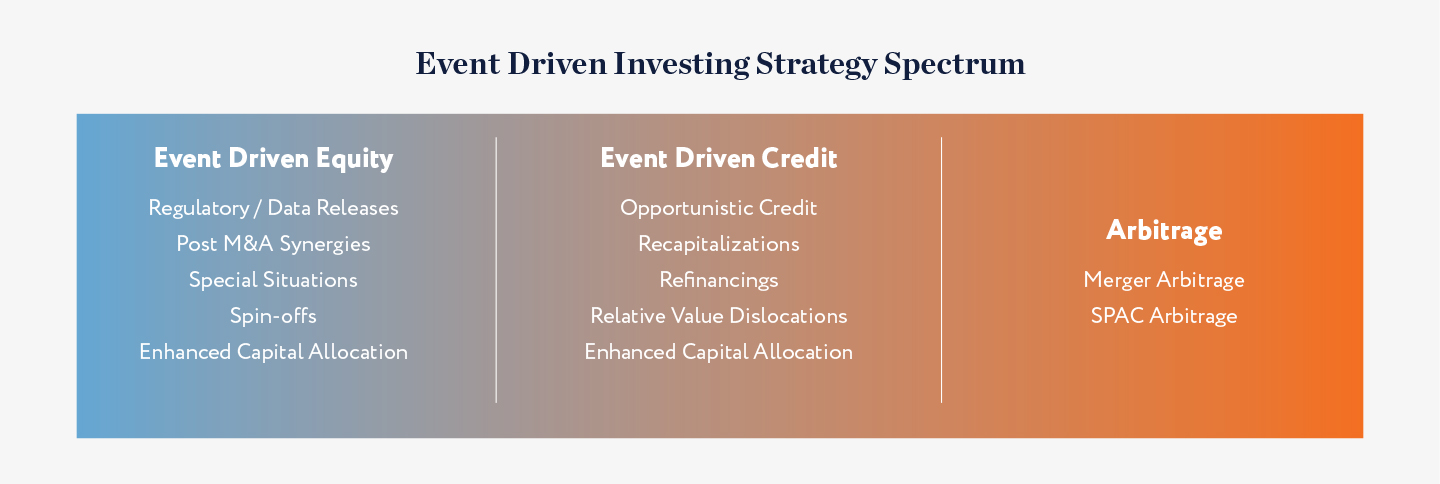One of the differentiating advantages of the Driehaus Event Driven Strategy is its expertise investing across the spectrum of corporate events and special situations.
While many event driven strategies apply a siloed approach in which they invest strictly in one event driven strategy (e.g. merger arbitrage), the Driehaus Event Driven Strategy benefits from the ability to invest in each of the three primary strategies of event driven investing: event driven equity, event driven credit and arbitrage. This expertise across multiple strategies allows us to allocate capital to opportunities that we believe offer attractive risk-adjusted return prospects.

An illustration of the advantages of this multi-strategy approach is the strategy’s investment in FGL Holdings (FGL), a financial holding company which was recently acquired by Fidelity National Financial (NYSE: FNF). The case study of the lifecycle of the FGL investment illustrates the benefit of implementing a multi-strategy approach across the event driven landscape.
Initial Investment as SPAC Arbitrage: When the strategy initially invested in FGL, the investment was part of our Arbitrage strategy, specifically the Special Purpose Acquisition Corporation (“SPAC”) Arbitrage strategy. Over the years, we have found SPACs to be a fertile area for attractive risk-adjusted returns. SPACs are common equity shares which carry imbedded downside protection and potential for share price appreciation upon consummation of an acquisition. This upside optionality without risk of permanent capital loss provides an attractive skew of risk and return.
The strategy’s investment in FGL started with a stake in CF Corporation (CFCO), the SPAC that acquired the company. In the case of CFCO and FGL, once the acquisition was announced the shares increased meaningfully and we decided to sell the shares.
Transition to an Investment in Special Situation Equity: Later in the year, the strategy invested in the standalone shares of FGL because we believed the company was meaningfully undervalued and the position would benefit from a number of intermediate term catalysts that would unlock value, such as the realization of post-M&A synergies, enhanced capital allocation and the potential for collaborative activism in the c-suite. As conviction grew in the position and its catalysts, so too did the position’s size and it became the strategy’s largest position for most of 2019 – at one point, the position size was approximately 700 basis points, with an average size of approximately 450 basis points.
As the company began to show wholesale progress in its post-M&A synergies, enhanced capital allocation and managerial changes, it was approached by an acquirer and, in February, 2020, it announced its merger with Fidelity National Financial (FNF) at a significant premium to its prior trading price.
Transition to Merger Arbitrage - Equity: The purchase consideration (a mix of cash and stock) carried an attractive merger spread of over 10% annualized and we believed the deal was highly likely to close due primarily to its strategic nature and the involvement of key related parties in the acquisition. So we decided to hold the shares while shorting shares of the acquirer in order to capitalize on what we believed was too low of an implied probability of deal closure.
Addition of Event Driven Credit: During the depths of the market’s decline in March, the price of FGL’s high yield bonds declined considerably and reached a level that presented a very compelling risk-adjusted return prospect. Specifically, we believed that FGL’s bonds would migrate to the A-rated investment grade backing of FNF once the acquisition closed and the consequent spread compression was an attractive prospect for the soon-to-be investment grade risk. Furthermore, the price of the bonds implied a probability of deal closure in the range of 50-60%, while the equity merger spread simultaneously implied a 90% probability of close. So, the bonds offered attractive relative value as both a merger arbitrage and a standalone long position. After the announcement of the deal closure, the bonds appreciated meaningfully and the strategy began to close the position.
The Driehaus Event Driven Strategy made its first investment in the company nearly four years ago and over the span of that investment, we enhanced returns by using multiple different event driven strategies. This lifecycle case study of the strategy’s investment in FGL illustrates the advantages imparted by investing with expertise across these multiple event driven strategies.
Learn more about the Driehaus Event Driven Strategy by downloading the fact sheet.
Disclaimer: The above example is representative of an investment that invested across multiple event driven strategies. It is unique to the portfolio due to the various investment strategies. The information presented is for illustrative purposes only. The strategy is actively managed and portfolio holdings, weightings and allocations are subject to change at any time. Driehaus assumes no obligation to update or supplement this information to reflect subsequent changes.
This information is not intended to provide investment advice. Nothing herein should be construed as a solicitation, recommendation or an offer to buy, sell or hold any securities, market sectors, other investments or to adopt any investment strategy or strategies. You should assess your own investment needs based on your individual financial circumstances and investment objectives. This material is not intended to be relied upon as a forecast or research. The opinions expressed are those of Driehaus Capital Management LLC (“Driehaus”) as of June 2020 and are subject to change at any time due to changes in market or economic conditions. The information has not been updated since June 2020 and may not reflect recent market activity. The information and opinions contained in this material are derived from proprietary and non-proprietary sources deemed by Driehaus to be reliable and are not necessarily all inclusive. Driehaus does not guarantee the accuracy or completeness of this information. There is no guarantee that any forecasts made will come to pass. Reliance upon information in this material is at the sole discretion of the reader.
Other Commentaries
Driehaus Event Driven Fund March 2024 Commentary with Attribution
By Yoav Sharon
Driehaus Event Driven Fund December 2023 Commentary with Attribution
By Yoav Sharon